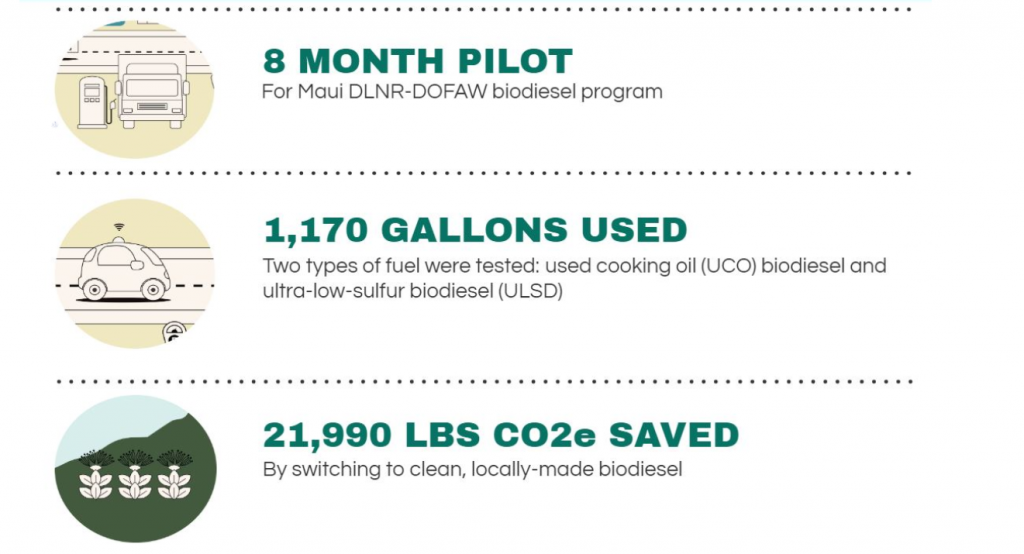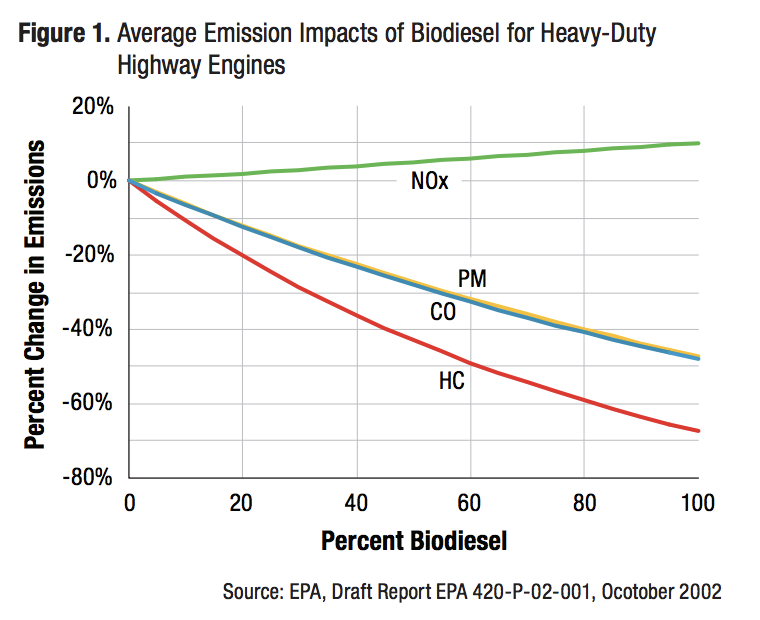- Home
- Critical Decade
- HI Climate Action
- HI Commission
- HI Resources
- HI Equity
- HI Events
Biodiesel FAQs

*This figure represents a conservative estimate calculated from the Biodiesel.org Emissions Calculator. The pilot used 908 gallons of B100 and 1308 gallons of B20. UCO biofuel, which generates significantly less CO2 emissions, was also used during the pilot program but was not included in the calculations due to a lack of specific data. Life cycle analysis completed by Argonne National Laboratory found that emissions for 100% biodiesel (B100) are 76.4% lower than those from petroleum diesel. The California Air Resources Board has reported similar values for its life cycle analysis of biodiesel from various sources.
Disclaimer: This information is intended to be used as a guide and resource for general informational purposes only. The technology of biodiesel (especially Biodiesel 100) and equipment/HDVs that use biodiesel is evolving, and this information will be updated accordingly. Specifics will vary with different equipment/vehicles. Specifics in this section are the result of preliminary conversations, pilots, and trials in Hawaii’s DLNR and other institutions, and are not applicable to every situation in Hawai‘i or elsewhere.
Neither the State of Hawai‘i nor any agency thereof, nor any of their employees, makes any warranty, express or implied, or assumes any legal liability or responsibility for the accuracy, completeness, or usefulness of any information, apparatus, product, or process disclosed, or represents that its use would not infringe privately owned rights. Reference herein to any specific commercial product, process, or service by trade name, trademark, manufacturer, or otherwise does not constitute or imply its endorsement, recommendation, or favoring by the State of Hawai‘i government or any agency thereof. The views and opinions of authors expressed herein do not necessarily state or reflect those of the State of Hawai‘i government or any agency thereof.
The information contained herein is general, and the authors strongly encourage
all parties with an interest in establishing biodiesel blends fueling systems to engage professional support. This document is not intended for use as a “how-to” guide for individuals or organizations performing conversions.
What is Biodiesel?
Biodiesel is a domestically produced, renewable fuel that can be manufactured from new and used vegetable oils, animal fats, and recycled restaurant grease. Biodiesel can come in a pure 100% biodiesel form (B100), or in blends mixed with petroleum diesel.
Biodiesel quality is strictly regulated under ASTM D6751 which mandates specific properties biodiesel fuel must have to be sold. According to Pacific Biodiesel, the only commercial producer of liquid biofuels in Hawai‘i, its biodiesel is of high quality and meets these regulations. Biodiesel fuel also has a higher cetane rating and superior lubricity in comparison to petrodiesel.
What is Biodiesel 20? What are the advantages of B20?
Biodiesel 20 (B20) is a blend of 20% biodiesel and 80% petroleum diesel. An advantage of B20 is that it is a cleaner fuel than pure petroleum diesel. B20 also represents a good balance of cost, cold-weather performance, materials compatibility, and ability to act as a solvent. Generally, B20 and lower-level blends can be used in current engines without modifications. Furthermore, engines operating on B20 have similar fuel consumption, horsepower, and torque to engines running on petroleum diesel. This means that a transition to biodiesel blends is easy and does not require change to your fleet.
What is Biodiesel 100?
Pure biodiesel, B100, offers several advantages to petroleum-based diesel fuels. As shown in figure pictured to the right, emissions of unburned hydrocarbons (HC), particulate matter (PM), and carbon monoxide (CO) decreases by 40-60% with the use of B100. While some studies of biodiesel have found it to have slightly higher emissions of nitrous oxide, the strict EPA limitations on nitrous oxide emissions from diesel engines in 2010 have mitigated this issue. Biodiesel use reduces greenhouse gas emissions because the carbon dioxide released in biodiesel combustion is offset by the carbon dioxide sequestered while growing the feedstock. B100 use reduces life-cycle emissions by 74% compared to petrodiesel. Using B20 reduces carbon dioxide emissions by roughly 15%.

What are the challenges of B100?
According to Pacific Biodiesel: “Most standard diesel engines can run on pure biodiesel without modifications. Running a diesel engine on B100 biodiesel may involve replacing non-compatible fuel lines. Some fuel systems will cause fuel to be entrained in the engine oil. These vehicles will require more frequent oil changes than when using petro diesel. If a vehicle increases oil level over time, the lube oil should be changed earlier than recommended by the manufacturer. No US built vehicles currently experience fuel-oil dilution when running on B100. For certain engines, however, some issues have been noted with sensors and computers. Biodiesel also contains less energy, about 8% less per gallon than traditional diesel. This can mean more frequent refueling and a decrease in MPG of vehicles using B100.”
Can I use B100 with heavy equipment?
Yes. Direct experience has shown that some specific engines work better than others with B100. Pacific biodiesel, for example, finds that certain engines have been working well on B100. Minor retrofits may be necessary for older equipment (i.e. fuel lines), and according to Pacific Biodiesel, certain companies in Hawai‘i have used B100 for their whole fleet of bulldozers, rock crushers, loaders, and trucks. Although they anticipated having to change filters more often, service schedules were unaffected by B100 use. Additionally, Pacific Biodiesel reports that Honolulu’s Daniel K. Inouye Airport generators were approved by Cat to run on B100 with no de-rating of capacity. Since construction, the site has employed B100 successfully. However, note that these are emerging findings, and more real-life trials continue, so these findings may change.
Where can I find biodiesel on my island?
Biodiesel availability below is from a survey done in late 2018 and has likely changed since then. If you are looking for the latest availability, we suggest you contact Pacific Biodiesel directly (Click here for more information)
How is biodiesel stored?
Biodiesel should be stored in airtight containers, avoiding exposure to sunlight, high temperatures, and water contamination. For long-term storage, biocides and stabilizers should be used. Biodiesel stored by two fleets on the islands use underground fiberglass double-walled tanks with interstitial monitoring. While shelf-life may vary based on conditions, biodiesel should not be anticipated to last more than six months. If a system contains sediments (prior diesel storage container), the tanks and fuel system should be cleaned before B100 is handled or used. B100 should not be stored in common plastics, or metal bins containing copper, bronze, lead, tin or zinc.
Based on conversations between two fleets that have used B20 and a third party, one found they had to clean storage tanks every 6 months (where previously they had done so every 18 months), and the other found they had never had to clean their storage tanks. One theory is that if biodiesel is used fast enough, sediments do not get a chance to settle, and therefore tanks do not get sediment deposits. Another theory is the possible difference in petroleum used in the mix, as these fleets obtain their petro-diesel from two different distributors.
What is the cost?
As of May 21, 2018, Pacific Biodiesel sold B100 for $4.14/gallon. This compared quite favorably with average petroleum diesel prices at the time (Kahului $4.099 per gallon; and Hawai‘i Island $4.32 per gallon). However, associated costs noted above (personnel time and downtime for vehicles) are not included here, and to be compared to those associated with petroleum diesel, marginal costs need to be factored in. Note: prices are constantly changing, we have posted only one snapshot of price at a time, to give a general idea of costs.
